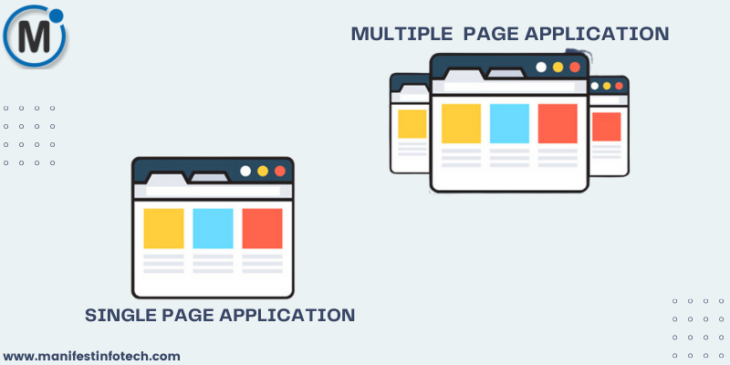
Single-Page Applications (SPAs) and Multiple-Page Applications (MPAs) are two different approaches to building web applications. They have distinct characteristics, advantages, and disadvantages.
𝐒𝐢𝐧𝐠𝐥𝐞-𝐏𝐚𝐠𝐞 𝐀𝐩𝐩𝐥𝐢𝐜𝐚𝐭𝐢𝐨𝐧 (𝐒𝐏𝐀):
A Single-Page Application is a web application that loads once and dynamically updates its content as the user interacts with it, without requiring full page reloads. The main characteristics of SPAs include:
𝟏. 𝐃𝐲𝐧𝐚𝐦𝐢𝐜 𝐔𝐩𝐝𝐚𝐭𝐞𝐬: SPAs use JavaScript frameworks (such as React, Angular, or Vue.js) to update the content dynamically without navigating to a new page. This results in smoother and faster user experiences.
𝟐. 𝐅𝐚𝐬𝐭𝐞𝐫 𝐏𝐞𝐫𝐟𝐨𝐫𝐦𝐚𝐧𝐜𝐞: Since only the required data is fetched from the server and only portions of the page are updated, SPAs generally offer better performance compared to traditional MPAs, as there is less data transfer and rendering overhead.
𝟑. 𝐒𝐦𝐨𝐨𝐭𝐡 𝐔𝐬𝐞𝐫 𝐄𝐱𝐩𝐞𝐫𝐢𝐞𝐧𝐜𝐞: SPAs provide a seamless user experience by minimizing interruptions caused by page reloads. User interactions feel more fluid and responsive.
𝟒. 𝐂𝐥𝐢𝐞𝐧𝐭-𝐒𝐢𝐝𝐞 𝐑𝐞𝐧𝐝𝐞𝐫𝐢𝐧𝐠: SPAs often perform rendering on the client side using JavaScript frameworks. This can offload some processing from the server but requires more client-side resources and can be less SEO-friendly.
𝟓. 𝐀𝐏𝐈-𝐃𝐫𝐢𝐯𝐞𝐧: SPAs often rely heavily on APIs (Application Programming Interfaces) to fetch data from the server. This makes them well-suited for applications that need to interact with various data sources.
𝐌𝐮𝐥𝐭𝐢𝐩𝐥𝐞-𝐏𝐚𝐠𝐞 𝐀𝐩𝐩𝐥𝐢𝐜𝐚𝐭𝐢𝐨𝐧 (𝐌𝐏𝐀):
A Multiple-Page Application is a traditional web application where each distinct page is a separate HTML file. When a user clicks on a link, a new page is loaded from the server. The main characteristics of MPAs include:
𝟏. 𝐅𝐮𝐥𝐥 𝐏𝐚𝐠𝐞 𝐑𝐞𝐥𝐨𝐚𝐝𝐬: In MPAs, each user interaction typically triggers a full page reload, which can lead to slower user experiences and more server requests.
𝟐. 𝐒𝐄𝐎-𝐅𝐫𝐢𝐞𝐧𝐝𝐥𝐲: MPAs are generally more SEO-friendly because search engines can easily index multiple pages with unique URLs.
𝟑. 𝐒𝐢𝐦𝐩𝐥𝐞𝐫 𝐈𝐧𝐢𝐭𝐢𝐚𝐥 𝐋𝐨𝐚𝐝: MPAs tend to have simpler initial page load processes, as the server sends the complete HTML page to the client. This can be advantageous for users on slower connections or devices.
𝟒. 𝐒𝐞𝐫𝐯𝐞𝐫-𝐒𝐢𝐝𝐞 𝐑𝐞𝐧𝐝𝐞𝐫𝐢𝐧𝐠: In MPAs, rendering can be performed on the server side before sending HTML to the client. This can improve initial load times and help with SEO.
𝟓. 𝐌𝐨𝐝𝐮𝐥𝐚𝐫𝐢𝐳𝐚𝐭𝐢𝐨𝐧: MPAs often have a clear separation between different pages, making it easier to organize and maintain large applications.
𝐖𝐡𝐢𝐜𝐡 𝐎𝐧𝐞 𝐭𝐨 𝐂𝐡𝐨𝐨𝐬𝐞:
The choice between SPA and MPA depends on your project’s requirements, goals, and resources. Here are some considerations:
– 𝐒𝐏𝐀𝐬 𝐚𝐫𝐞 𝐬𝐮𝐢𝐭𝐚𝐛𝐥𝐞 𝐢𝐟: You want to provide a smooth and interactive user experience, need real-time updates, and have the resources to manage client-side rendering and handle potential SEO challenges.
– 𝐌𝐏𝐀𝐬 𝐚𝐫𝐞 𝐬𝐮𝐢𝐭𝐚𝐛𝐥𝐞 𝐢𝐟: You prioritize SEO, need simpler initial load times, and have a more content-focused website where users frequently navigate between distinct pages.
If you are looking for any services related to Website Development, App Development, Digital Marketing and SEO, just email us at nchouksey@manifestinfotech.com or Skype id: live:76bad32bff24d30d
𝐅𝐨𝐥𝐥𝐨𝐰 𝐔𝐬:
𝐋𝐢𝐧𝐤𝐞𝐝𝐢𝐧: linkedin.com/company/manifestinfotech
𝐅𝐚𝐜𝐞𝐛𝐨𝐨𝐤: facebook.com/manifestinfotech/
𝐈𝐧𝐬𝐭𝐚𝐠𝐫𝐚𝐦: instagram.com/manifestinfotech/
𝐓𝐰𝐢𝐭𝐭𝐞𝐫: twitter.com/Manifest_info
#SinglePageApp #SPA #WebApp #DynamicUI #JavaScriptFrameworks #React #Angular #VueJS #ClientSideRendering #UserExperience #SmoothInteractions #RealTimeUpdates #APIDriven #FrontEndDevelopment #WebDevelopment #MultiPageApp #MPA #TraditionalWebApp #SEO #ServerSideRendering #HTMLPages #UserFriendly #Navigation #ContentFocused #SearchEngines #InitialLoadTime #Modularization #WebDesign #PageNavigation #WebsiteStructure